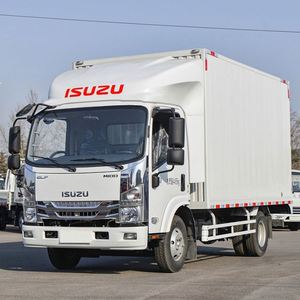
All categories
Featured selections
Trade Assurance
Buyer Central
Help Center
Get the app
Become a supplier

(5069 products available)










































The Isuzu manual transmission enables drivers to have more control over the vehicle's power delivery to the wheels. The Isuzu manual transmission is offered in the following types;
Five-speed manual transmission:
The Isuzu five-speed manual transmission, also known as the Isuzu 5-speed M/T, has a gearbox with five forward gears and one reverse gear. The five-speed manual transmission gives more precise control over torque delivery to the wheels. It also allows for smoother and quieter operation at higher speeds. That is why the Isuzu five-speed manual transmission is ideal for off-road enthusiasts, sports car lovers, and truck drivers.
Six-speed manual transmission:
The Isuzu six-speed manual transmission, also known as the Isuzu 6-speed M/T, has a gearbox with six forward gears and one reverse gear. The Isuzu six-speed manual transmission is designed to improve vehicle performance and fuel efficiency. It does this by allowing the engine to operate at lower RPMs when driving at high speeds. The Isuzu 6-speed M/T is a perfect choice for performance cars, luxury vehicles, and heavy-duty trucks.
Isuzu 4-speed manual transmission:
The Isuzu 4-speed manual transmission, also known as Isuzu 4-speed M/T, is a gearbox with four forward gears and one reverse gear. The Isuzu 4-speed manual transmission is designed to provide smooth gear changes and reliable performance. That is why the Isuzu 4-speed manual transmissions are mostly used in compact cars, commercial vehicles, and budget-friendly vehicles.
There are many specifications to consider when dealing with Isuzu gearboxes. They include the number of gears, shift mechanism, gear ratios, materials, and case design.
Number of Gears
Isuzu manual transmission has 5 to 6 forward gears. The gears provide a wide range of ratios to improve performance and fuel efficiency in various driving conditions.
Shift Mechanism
There are 2 shift mechanisms in Isuzu manual transmissions. The first one is the conventional one, which uses rods to connect the gear stick and the transmission. The second one is the remote shift mechanism, which uses cables to connect the gear stick and the transmission.
Gear Ratios
Gear Ratios in Isuzu gearboxes vary depending on the model. The ratios are designed to improve engine performance and give a smooth driving experience. With the ratios, the vehicle can handle steep slopes and accelerate quickly.
Materials
Isuzu manual transmission uses aluminum alloy to make the gearbox case. The case enhances strength and reduces weight. The gear teeth and shafts are made of high-quality steel to increase durability.
Case Design
The Isuzu manual transmission case has a compact design. The design reduces friction and makes the transmission efficient. It also reduces the weight of the transmission.
To keep Isuzu manual transmission in good condition, it is important to follow these maintenance guidelines:
Before buying an Isuzu manual transmission for resale, it is important to consider several factors. These include:
Vehicle Compatibility
To ensure compatibility, buyers should Isuzu manual transmission parts for each Isuzu vehicle model. They should also consider the Isuzu model, engine size, and production year.
Gear Ratios
The gear ratios accommodate different driving styles and preferences. Buyers should consider their business customers' needs and the driving conditions they frequently encounter.
Transmission Size and Weight
When selecting the proper size and weight of the Isuzu manual transmission, buyers should consider the vehicle's size and specifications. They should also consider the manual transmission's mounting points and available space.
Driving Experience
Buyers should consider the Isuzu manual transmission features, such as the short shifter for a sporty feel. They should also consider the clutches and flywheels that suit various business customers' needs.
Quality and Reliability
Buyers should source Isuzu manual transmissions from reputable manufacturers that offer warranties. They should research the reviews and feedback of their business customers regarding the manual transmission's performance and durability.
Budget
To ensure they stay within their budget, buyers should compare the prices of various Isuzu manual transmissions. They should also consider the long-term maintenance and repair costs of each manual transmission.
Professional Advice
Buyers can source helpful information from automotive mechanics and professionals. The professionals can help them select suitable Isuzu manual transmissions that meet their business customers' needs.
Replacing Isuzu's manual transmission can be a complex task that typically requires a good understanding of automotive mechanics. It also requires specialized tools. Before attempting to replace a manual transmission, ensure that the warranty is not voided and that local regulations regarding vehicle modifications are followed. Here's a general guide on how to replace an Isuzu manual transmission:
Before starting, gather the following tools and materials:
Replace the Isuzu manual transmission
Q1: Are Isuzu manual transmissions reliable?
A1: Yes, they are generally reliable. They require regular maintenance to ensure their durability and reliability.
Q2: Can the clutch of an Isuzu manual transmission be adjusted?
A2: Yes, the clutch can be adjusted. Manual transmissions usually have a clutch pedal that can be adjusted for desired engagement and disengagement points.
Q3: Can Isuzu manual transmissions handle high torque applications?
A3: Isuzu manual transmissions can be designed to handle high-torque applications, especially in commercial vehicles. It depends on the model and specifications of the vehicle.